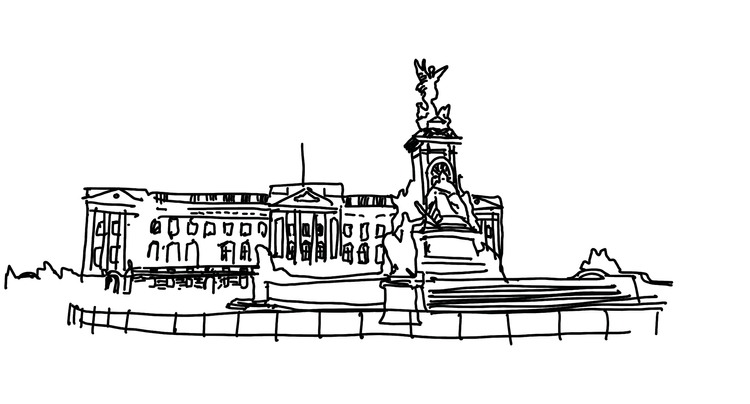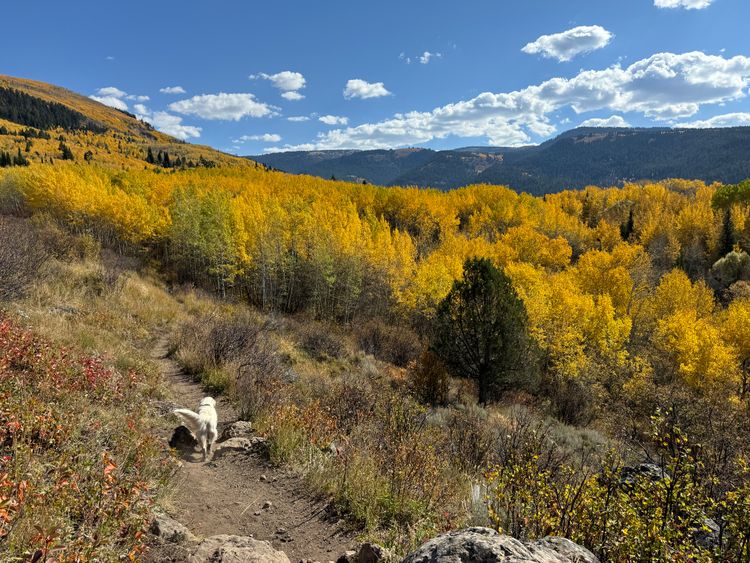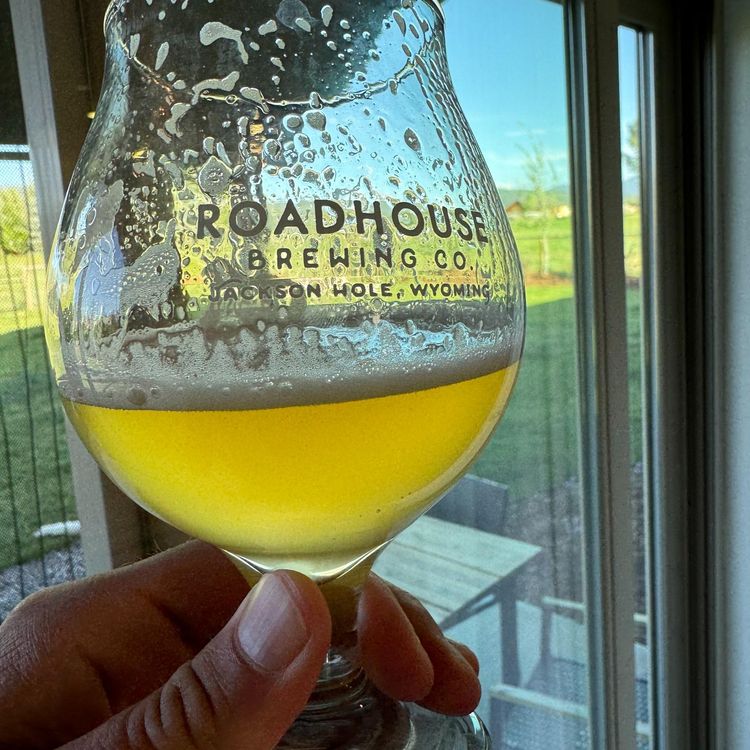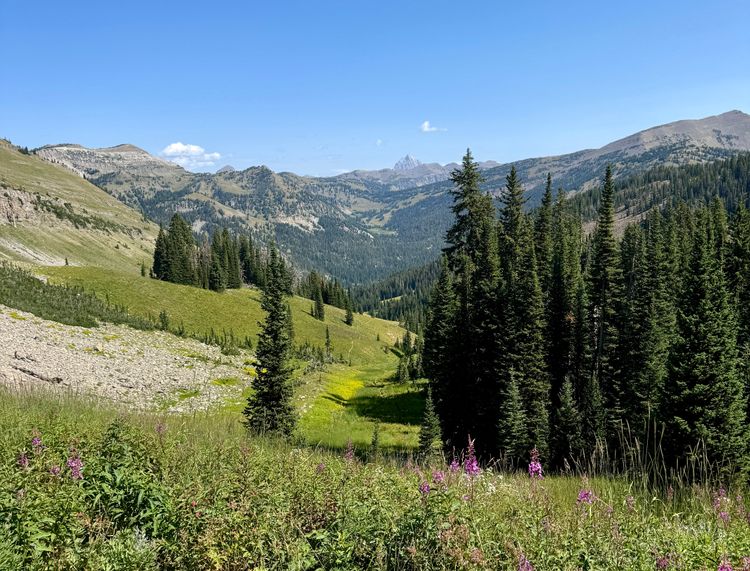Climbing Denali
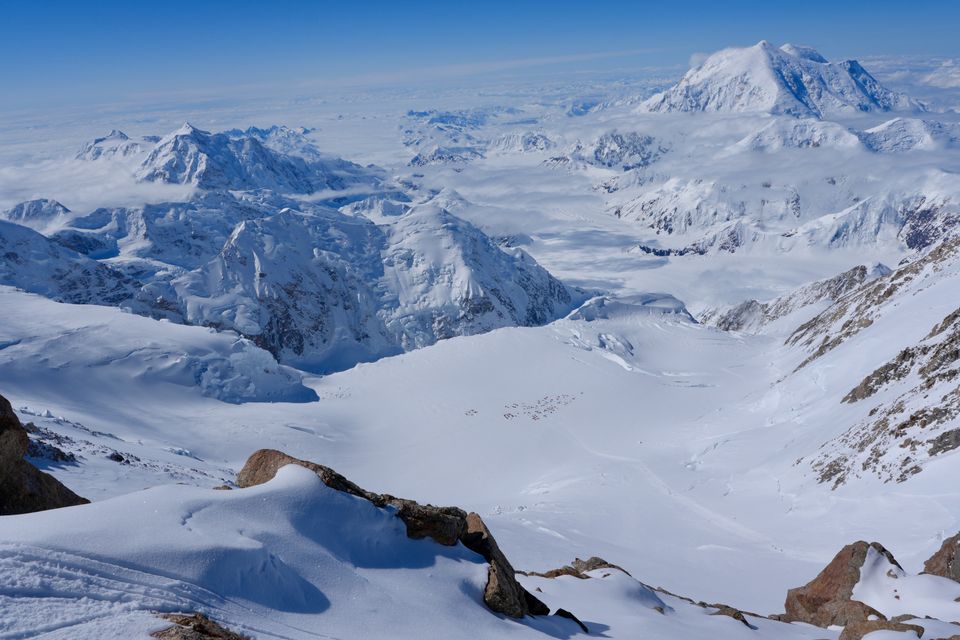
The West Buttress of McKinley [Denali], it is often said, has all the technical challenges of a long walk in the snow. That is more or less true, but it's also true that if you should, say, trip on a bootlace at the wrong moment during that walk, you will probably die.
—Jon Krakauer, Eiger Dreams: Ventures Among Men and Mountains
For me, this all started two years ago in Wyoming. Along with my dad and a good friend, I signed up for a climb of the Grand Teton, which felt like another type of tourism while we passed through Jackson Hole. I didn’t intend for this side quest to go any further than that, but the mountains have a way of pulling you in.
As you climb more, bigger peaks and more challenging routes call to you. It can get you into trouble. But, when a hard ascent works out, you often discover you can take a lot more pain and difficulty than you imagined. That feeling of overcoming is incredibly gratifying and addictive. Summiting and descending the Grand made me feel like I passed a test of self, and I wanted more.
On the descent, I walked next to a guide named Pete and I asked him what mountains people go for after the Grand. "Ever heard of Denali?" he asked. "If you're serious about this stuff, that's what I'd set your sights on. Tallest peak in North America. It's a good idea to get some practice on glaciers beforehand though; it's a different style of climb." As soon as I got home, I started mapping out a plan.
The Cascades Range, which runs through Washington, Oregon, and Northern California, is where many climbers train up for Denali, myself included. While it’s pretty much impossible to simulate the weather in Alaska in the Lower 48, you can log a lot of time on glaciers there. I completed the Ingraham Direct on Rainier, Hotlum-Bolum on Shasta, the Easton Glacier of Baker, and the Sulphide Glacier route on Shuksan. In September, I signed up for the May 5, 2024, West Buttress Denali expedition through RMI.
You’ll find a lot of debate online around the value or necessity of a guide on this mountain. Personally, it was an easy decision: Guided teams have higher summit success rates than unguided teams on Denali , mostly because they’re equipped to make better decisions and they have experience with the conditions, which are some of the most notoriously brutal in the world. In the week before I left for Alaska, the summit temps were routinely -80 Fahrenheit with wind chill.
But there are factors that steer even inexperienced climbers away from guide services. You don’t know who’s in your group or their abilities, you don’t have control over many of the logistics or the pace, and you’re not on equal footing with the guides since they’re always calling the shots. It’s just part of the deal. But the added safety margin that comes with a service outweighed all of this for me, especially for my first time in the range.
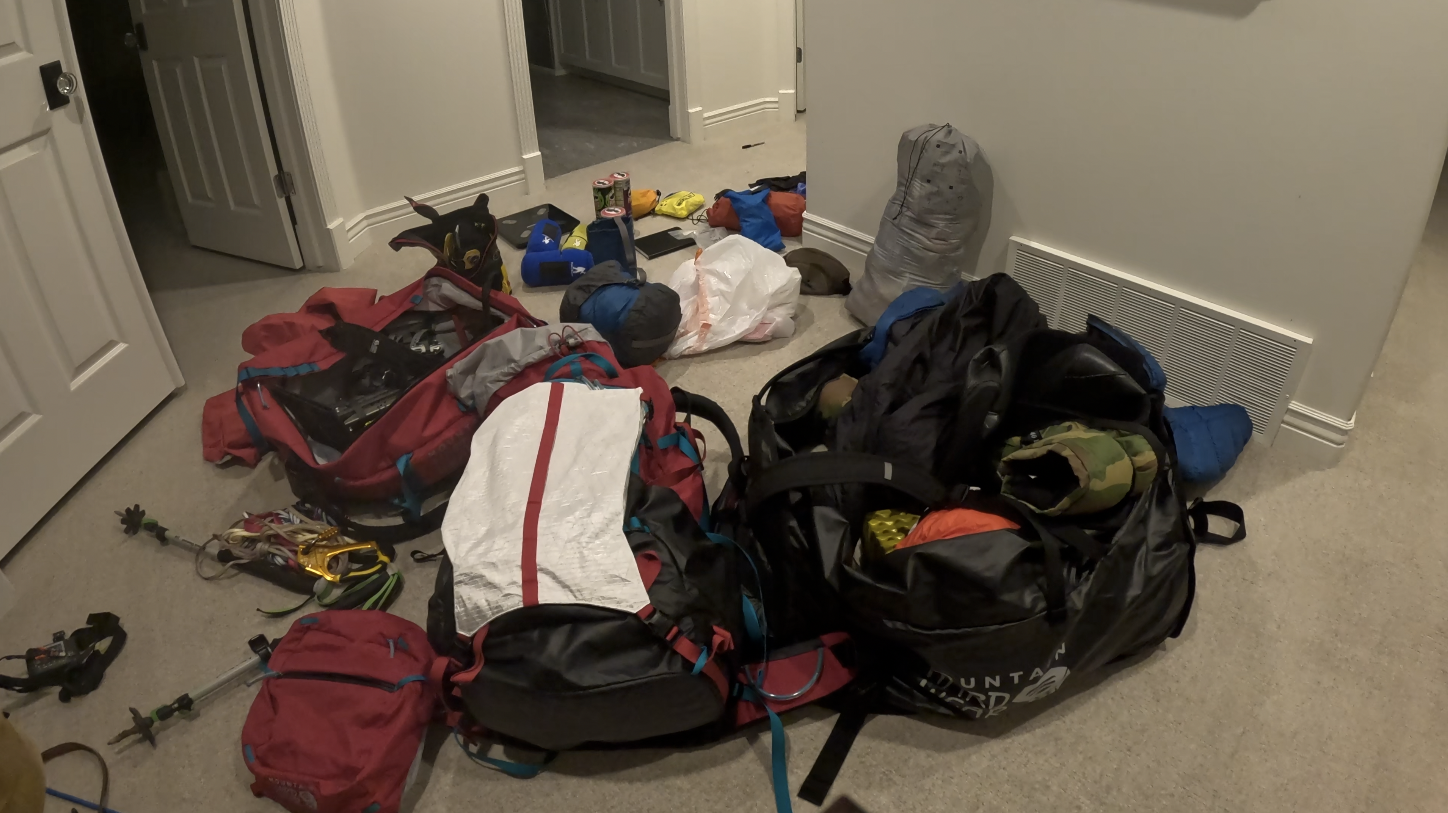
I pieced gear together during the months leading up to the climb. A few days before, I laid it all out on the floor and inventoried it with a checklist many, many times. Most people end up with two very large duffles of gear and a backpack, like me. If you’re more efficient than I was, like some of my teammates, you can squeeze your backpack into a duffle and consolidate to two. I had in excess of 100 pounds of gear and food, and I kept wondering how I was going to lug this all up on the climb. There’s no such thing as a porter on Denali.
I set off on the morning of May 4. Salt Lake, to Seattle, to Anchorage. It felt like a homecoming.
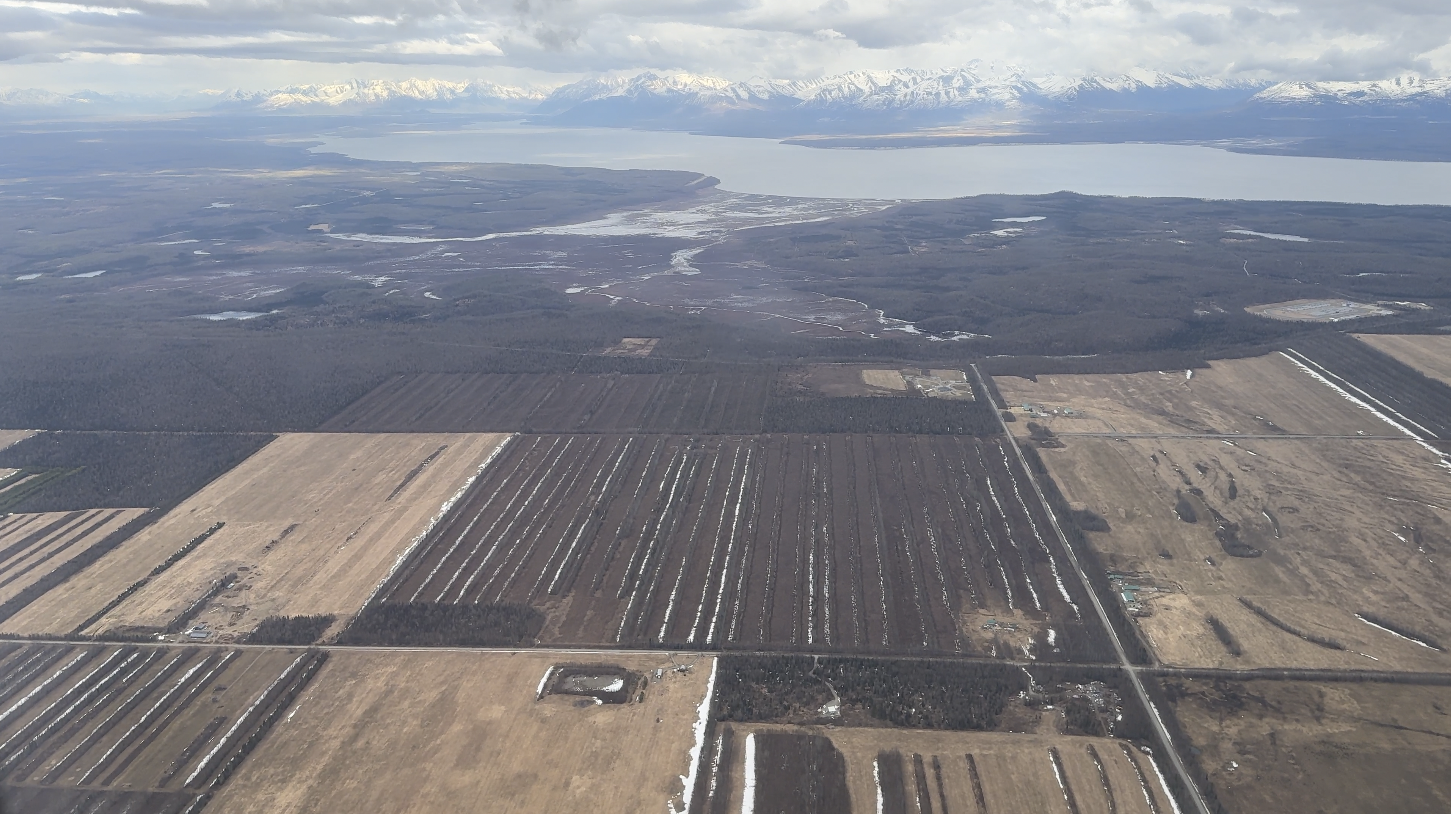
I was born in Anchorage on Elmendorf Air Force Base, where my dad flew fighters in the 90s. I kept thinking about how this climb, the biggest endeavor of my life to date, was taking me full circle, back to my roots. On the journey up to Talkeetna, we would pass Eagle River, the site of my parent’s first house as a married couple. My dad would tell me stories about dogfight practice above Denali in his F-15. Sure enough, we’d later see the F-22s that replaced those squadrons doing the same thing.
I stayed at the Lakefront Hotel so I could be close to the airport, where I’d rendezvous with the team for the first time the next day. The Lakefront immediately lets you know you’re in Alaska, with a wide array of taxidermy and guns on display, and, of course, float planes in the backyard. This seaplane base on Lake Hood is the largest in the world.
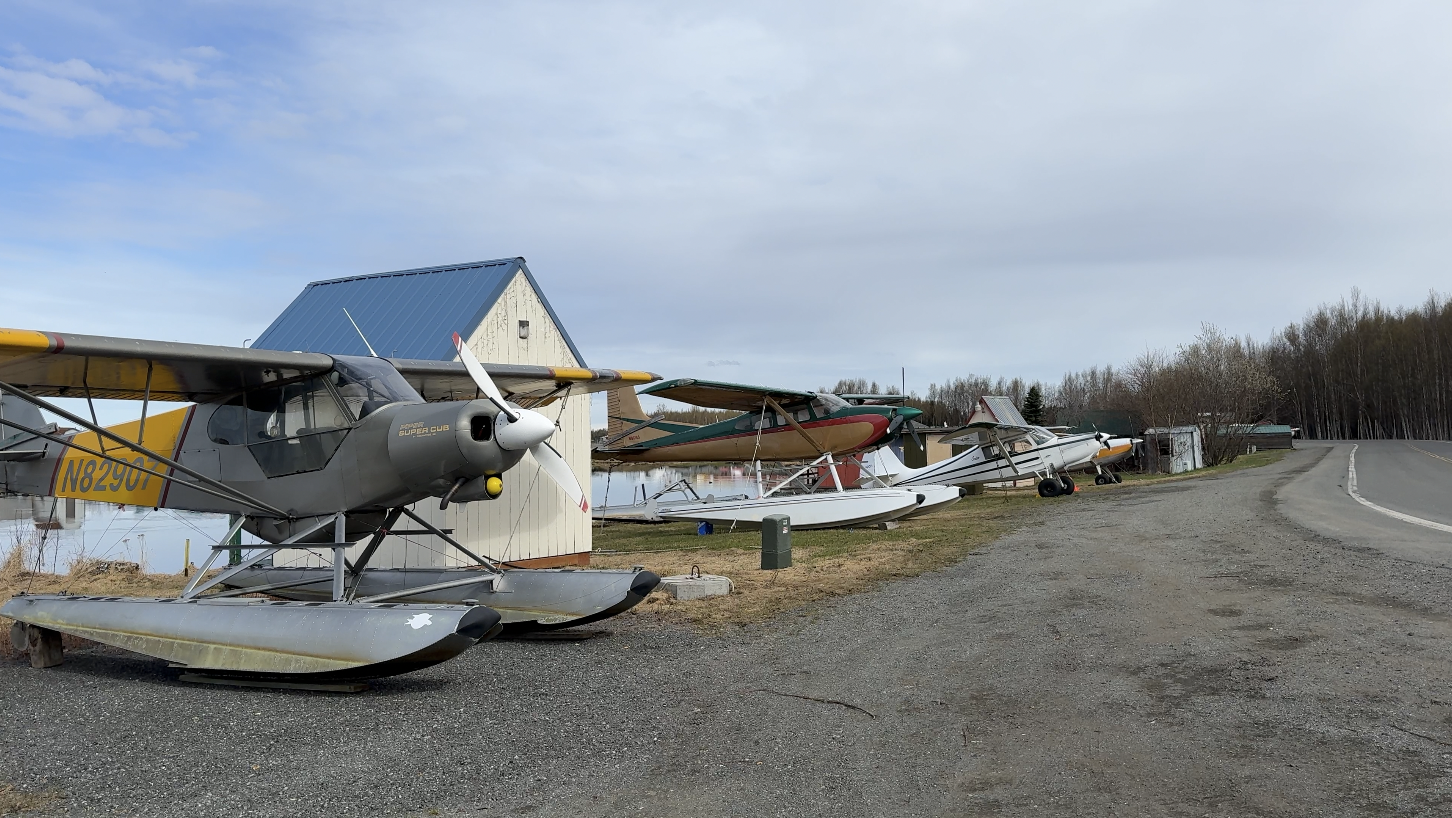
At 1:00pm the next day, I met the team at baggage Carousel 1 back at the airport. We loaded our gear into the shuttle trailer and set off for Talkeetna, which is the traditional staging area for Denali climbs. After a pitstop in Wasilla for some last-minute groceries, we arrived at K2 Aviation and unloaded our gear into the hangar. The most common way of beginning the climb is to fly onto the Kahiltna Glacier.
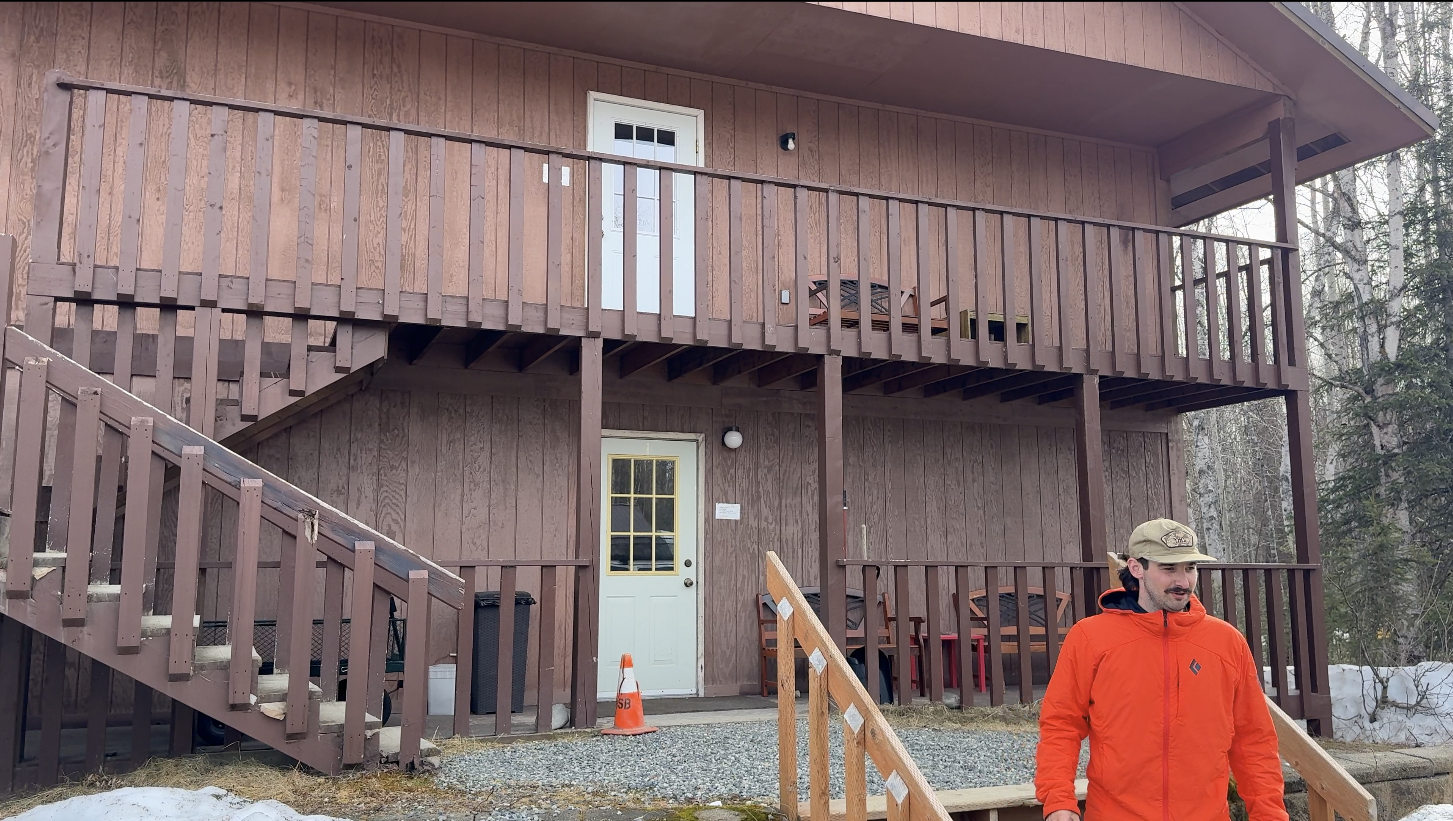
Our group stayed at the Swiss Alaska Inn, which is a wonderful, family-owned operation down the road. The rooms are basic but comfortable.
We grabbed food at Denali Brewing in town and then ventured over to the Susitna River to see if we could get a look at Denali. It was partially obscured in clouds, but you could still get a sense of its enormous scale, compared to everything around it.
The next morning dawned rainy. Not a flying day. This didn’t phase me much, because I’d read that three to four days of waiting for a weather window in Talkeetna was pretty customary.

We walked back to the hangar at K2 to start organizing the group gear. I popped over to K2’s main office to buy a few souvenirs before I forgot, and I was surprised to find a framed hat and letter from Rob Hall. Hall passed away while guiding on Everest in 1996 in an infamous disaster that claimed the lives of seven other people, and he was one of the main personalities featured in Jon Krakauer’s Into Thin Air, which documented the tragedy. Hall apparently climbed all of the Seven Summits while wearing this very ball cap.
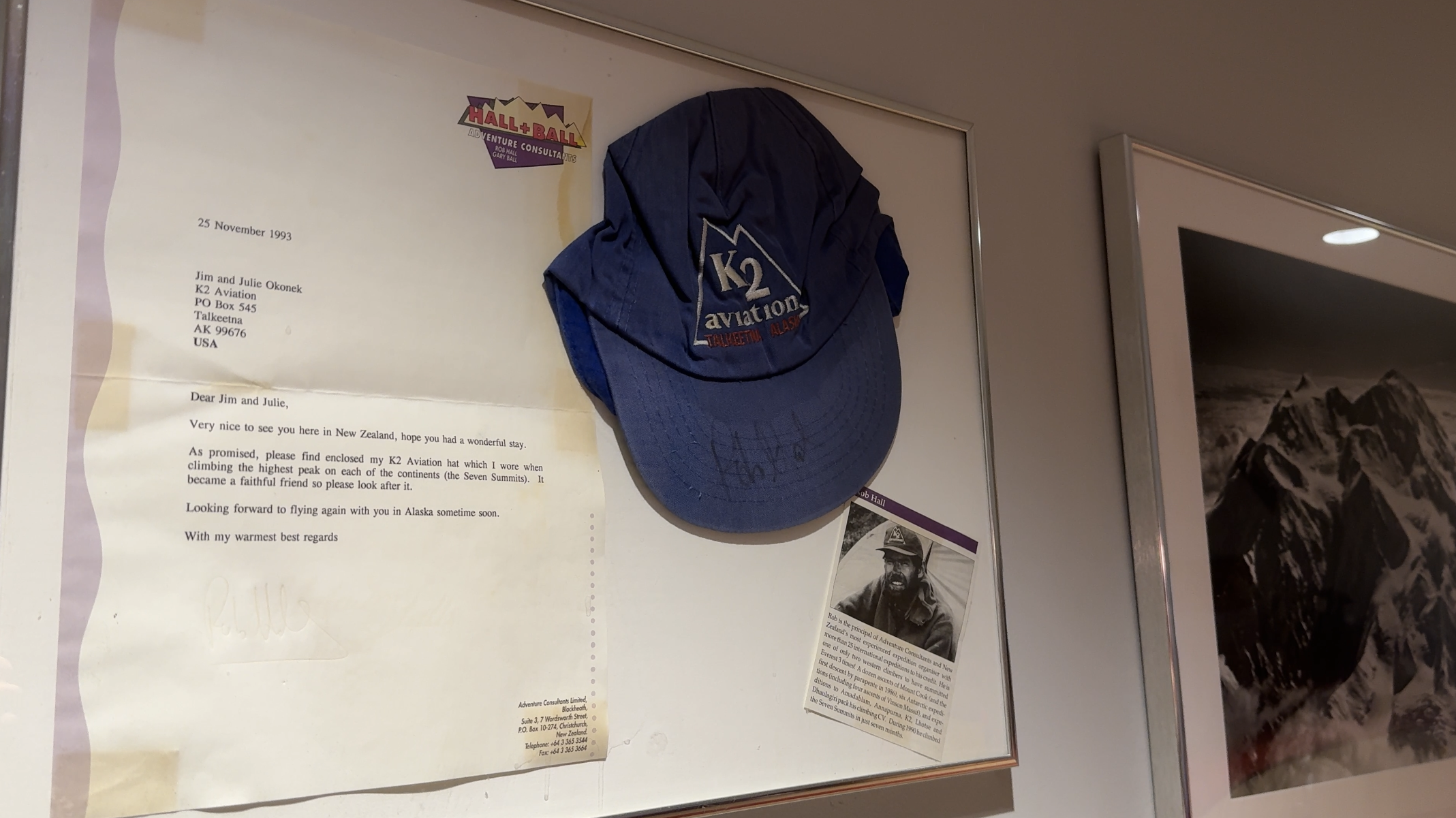
We received a very short briefing from Alan, a climbing ranger with the Park Service. I was expecting a fire and brimstone speech about the dangers of Denali, but his message boiled down to “listen to your team lead.” This made some sense, as Alan himself was trained by our lead guide, Mike Walter, prior to him joining the Park Service. We’d later regularly see Alan and his crew of volunteers at work on search and rescue.
The next morning, our third day in Talkeetna, the sky cleared of clouds. We were buzzing with optimism about our chances of flying onto the glacier. We had to wait a while for a signal from K2. The weather is squirrely. It can be beautiful in Talkeetna while blizzards rage at Basecamp on the Kahiltna.
The air service has to weigh all of your stuff to make sure they’re within capacity limits. My sled duffle weighed in at 68 pounds, with something like 40 more in my backpack. In retrospect, this was way too much. But it’s hard to know exactly what you’re getting into with an adventure like this, so I erred on the side of more than I thought I’d need.
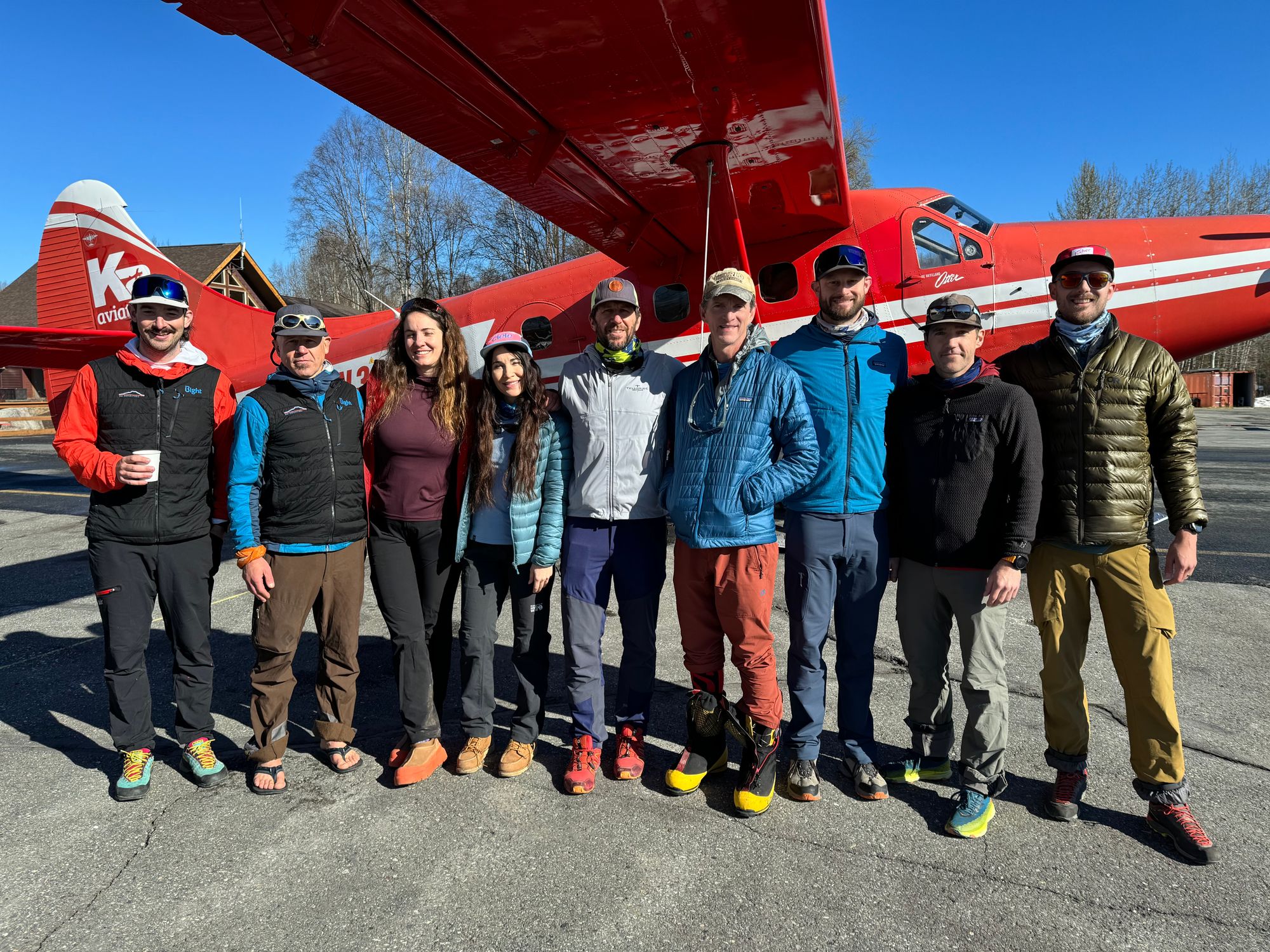
K2 tends to fly climbers onto the Kahiltna using DeHavilland Otters, which are turboprops that can carry an astonishing amount of weight and have the power to weave around the beautiful and treacherous terrain we were heading into. Our pilot gave us a quick briefing and let me sit in the co-pilot seat, which is equipped with its own rudder pedals and yoke. I resisted the urge to test them out.
The flight over the tundra and onto the Kahiltna is like nothing I’ve ever experienced in an airplane. You shave close to jagged peaks and catch a bird’s eye view of some of the longest glaciers in the world, sliced through with crevasses. Off in the distance, I sighted the Moose’s Tooth, and I was again reminded of the historical weight of this place. Bradford Washburn, who pioneered aerial photography in the Alaska Range, scouted the West Buttress route from the air and led its first expedition in 1951.
After landing, which was remarkably gentle, considering we touched down on a glacier using skis, we shuttled gear from the plane onto the hill next to the airstrip.
Mike decided we’d spend the night at Basecamp. We stomped out a platform and pitched our tents.
It was hot. The ambient air temperature on the glacier can be 0 degrees Fahrenheit or colder, but the radiation from the sun on a clear day is so intense that you can be sweating in a base layer.
The daily temperature swings cause all kinds of crazy things to happen. I overheard some commotion as we were setting up and turned to see both Mt. Crosson and the nearest face of Mt. Hunter sliding at almost the same time.
We settled into what would become the normal rhythms of camp life. You get to a new spot, you deploy the tents, and cooking gear, and you build a latrine. We were very proud of our first multi-stall design, where we cordoned off the clean mountain can from the pee hole with sleds. But none of us was bold enough to actually use a stall while the other was occupied.
Later in the tent, I settled into some Tolkien as we wound down for our first night. Little did I know at this point how routine this activity would become.
As soon as we lost the sun, the temperature plummeted to something well into the negative.
The next morning we rigged the sleds for the single carry up the Kahiltna to Ski Hill Camp at 7,800ft. Did I mention how cool you look with all of the sun protection on?
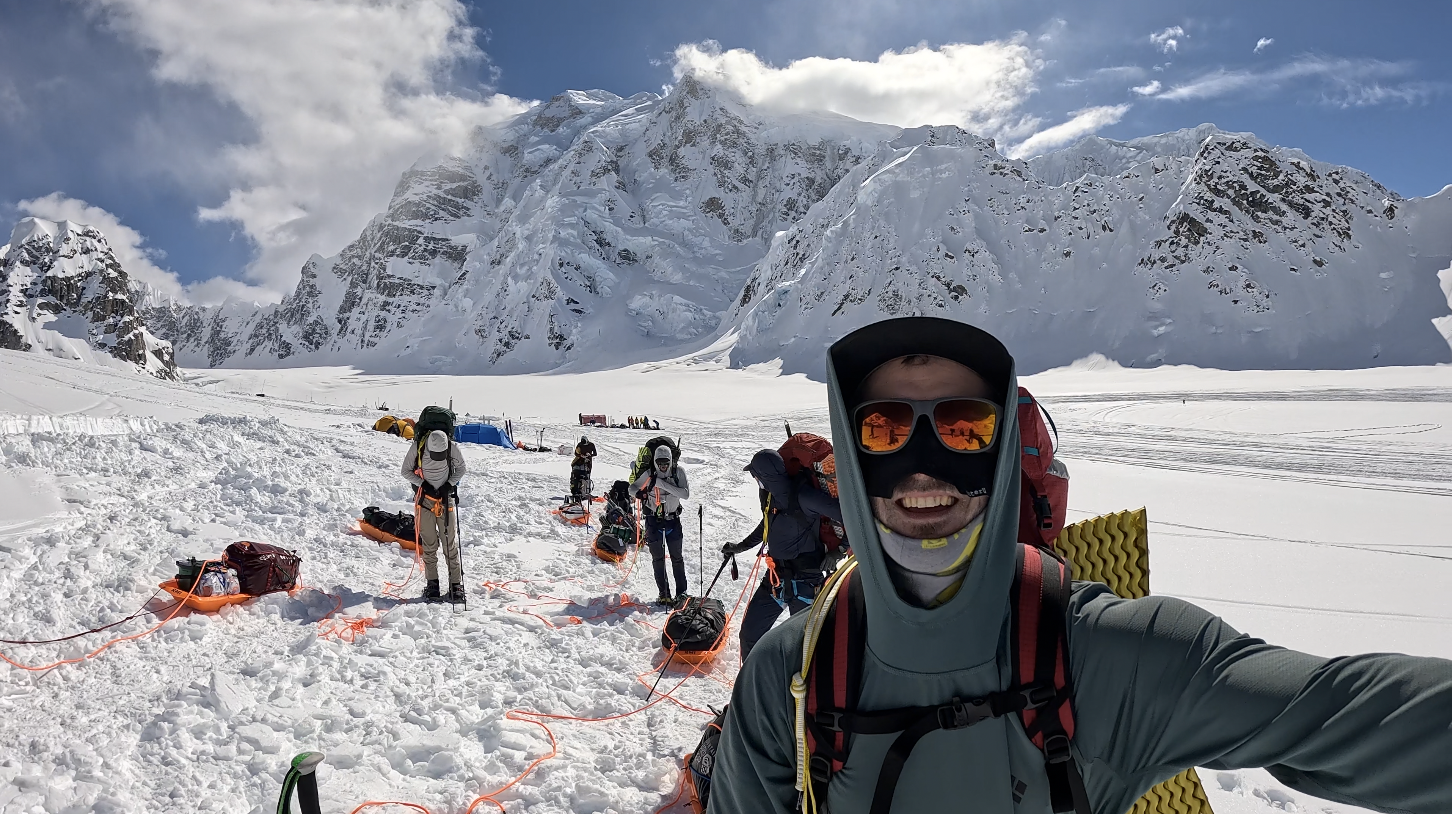
Basecamp sits at 7,200ft, so you’re mostly traveling the five and a half miles over rolling, gently rising terrain. It feels essentially flat most of the time. Tugging the sled uphill wasn’t as bad as I expected.
There is almost no wildlife in this environment. When you stop moving and the wind quiets down, you’re left with a dead silence. But once in a while, we’d see something surprising. I asked Mike how these small birds would get here, and how they survived. He replied that they likely get caught in high winds from down on the tundra and simply find themselves here, mostly doomed to die without much to eat or to drink. They would become food for the savvier and rugged ravens, which are the main pests to climbers, opportunistically stealing food from poorly buried caches or unattended tents.
We arrived at Ski Hill, and I was very ready to throw the pack down and be done with the sled for the day. After probing the area for crevasses, we deployed camp and tucked into our first meal in the Hilleberg.
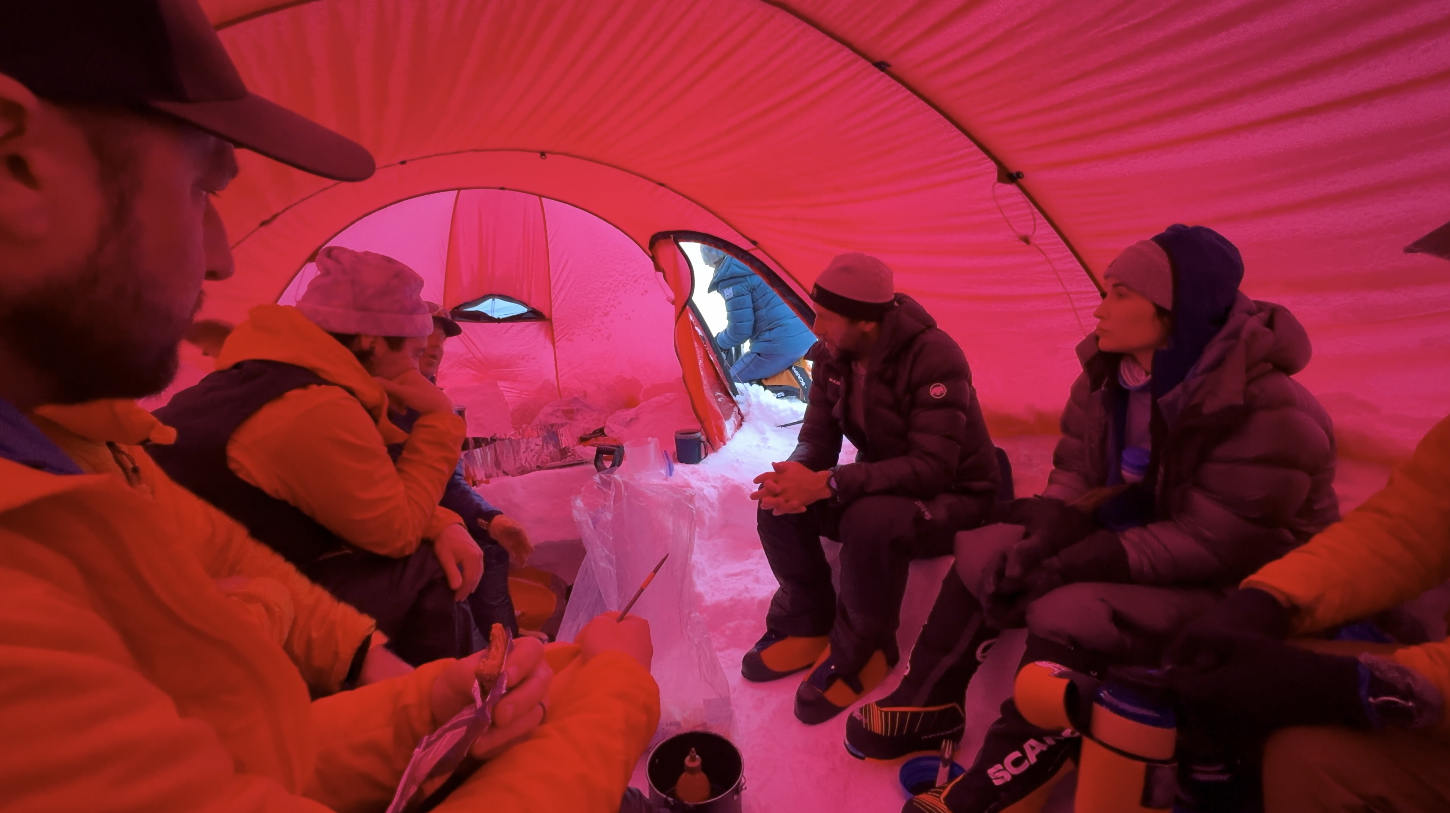
It’s said that you camp your way up Denali, and the generally accepted modern formula for the West Buttress involves climbing the mountain nearly twice. Since you have so much gear and food, the trick is to push it up higher in chunks and then return to your camp to sleep. So, these caching missions like we ran up Ski Hill to about 9,800ft were part of the strategy. The cache holes are very deep, mostly to ensure neither ravens nor weather could get at our precious supplies.
So far, we were on schedule and the weather was cooperating. On May 10, we made our move toward 11,000ft camp, which is the first camp that really feels like it’s on Denali. The angle of the terrain kicks back and it finally looks like a climb. The day started nicely, but in classic fashion, it deteriorated when we hit a storm hugging the slopes up higher. We made it to about 9,400ft and Mike halted us and we pitched the tents.
Over the next two days, we made it to 11,000ft, dug in, and then retrieved our cache from down low. Watching the Climbing Rangers snag powdery lines on the face above camp made me badly wish I had my skis.
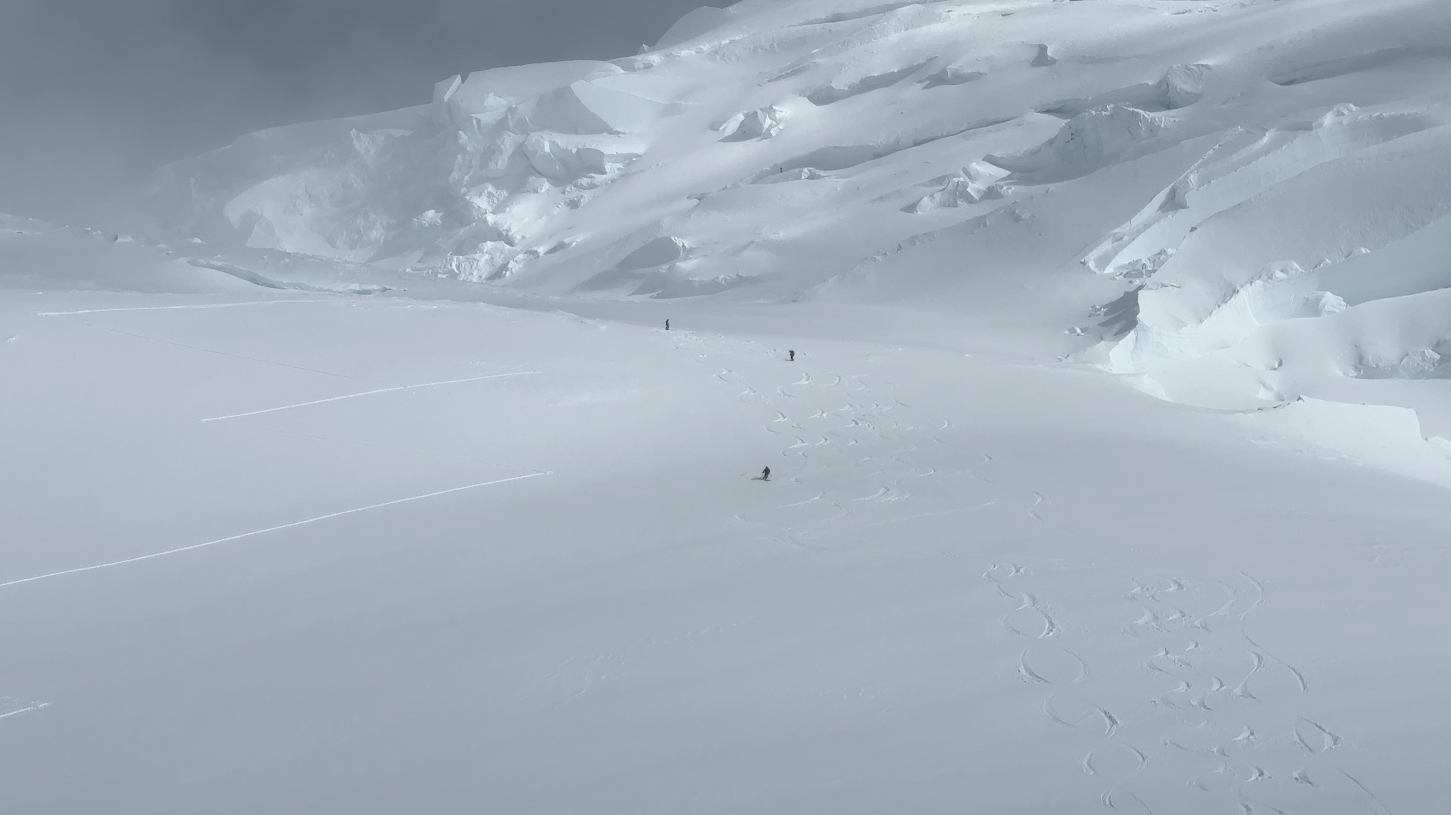
After a rest day, we moved cache supplies to 13,500ft, just below the next major camp at 14,200ft. To get there, you scale Motorcycle Hill, which reveals the massive and striking Father and Sons Wall. You then head up Squirrel Hill and cross the Polo Field below Windy Corner, an infamous spot renowned for gale-force winds as the air funnels into the pass there.
When we returned to 11,000ft camp, I was in pretty good spirits. We were maintaining pretty much the ideal pace for a Denali itinerary. I began to wonder if we had become blessed with a pattern similar to 2022, which saw sustained, gorgeous weather for most of the summer and some record-high summit rates.
We rested the following day. Rest and weather days can be long. You’re completely disconnected from the internet, so you have to rely on the entertainment you have with you and your own creativity to help pass the time. I discovered to my horror that all the movies I’d downloaded to one of the streaming apps were not accessible. It kept prompting me to connect to a network. Back to Tolkien on the Kindle.
On May 15, we learned that a member of our party wanted to turn back to basecamp, so we parked it again for the day while two of the guides ran him down the glacier. Another day in the tents. We watched with some curiosity as another guided team went over self-arrest and walking in crampons. It struck us as pretty odd that this would be the first mountain where one would learn those things, but to each their own. Back in the cook tent, we listened to the weather report for the following day. The winds were picking up.
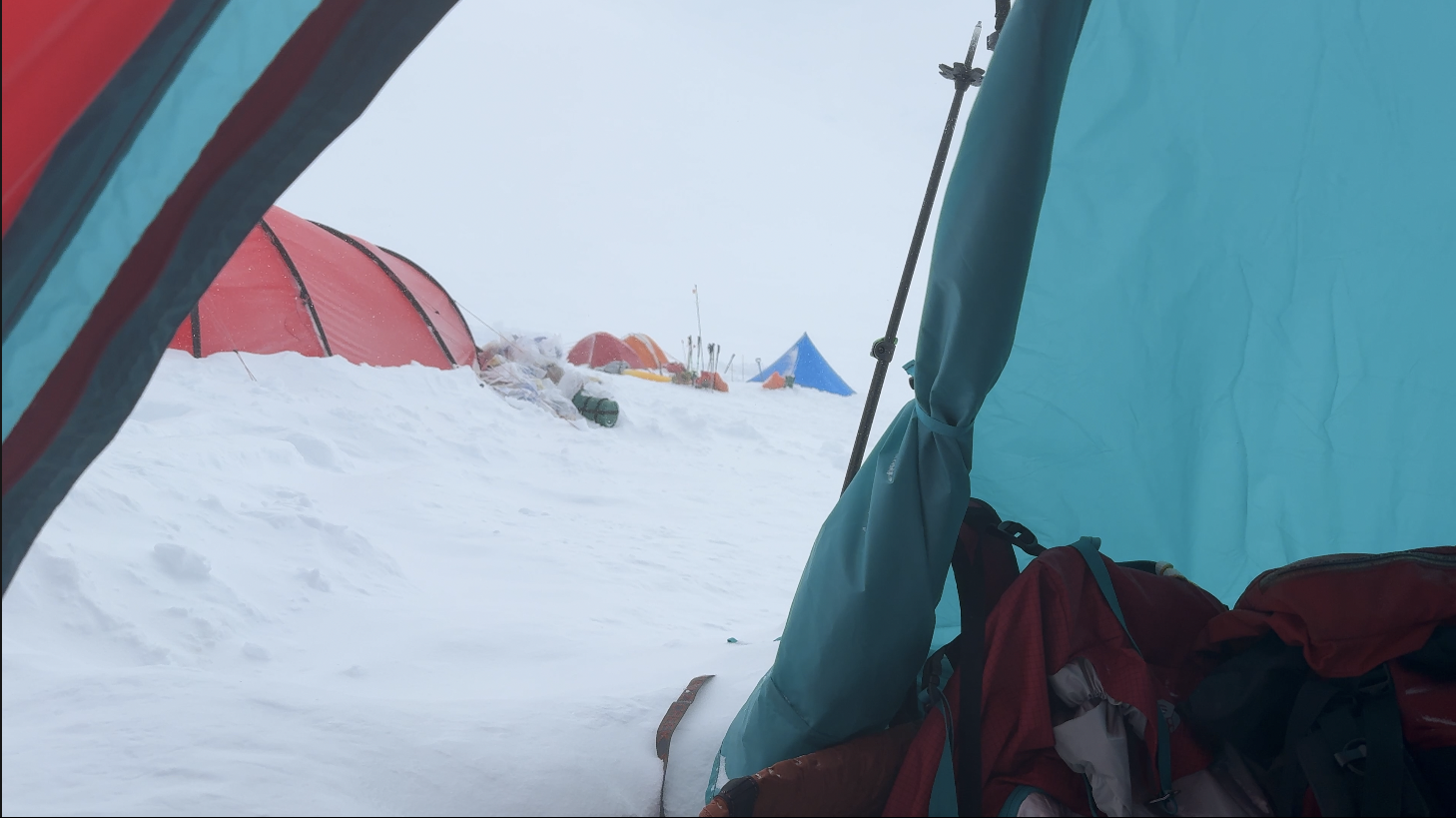
Sure enough, on May 16, we parked it again at 11 Camp. The wind was whipping. In other places, where the ambient air temperature is not in the negative teens, you might just go for it. But this is not what you do on Denali, where the wind chill drives temps so low that you risk almost instant frostbite to any exposed flesh.
I was starting to go a little insane. I love the Lord of the Rings, but there comes a point, maybe after hour six on the Kindle, where I can’t force myself to read any more Tolkien. My tentmate, James, and I began to call the state you drift into “hibernation mode.” I would stare at the buffeting ceiling of the tent, lost in my own thoughts, shut my eyes, open them, and realize hours had passed. You enter an uncanny zone between consciousness and sleep. This is probably table stakes for most hardcore expedition climbers, but the boredom and long hours in a flapping tent were new to me. I’d been pinned down in weather before, but nothing to this extent.
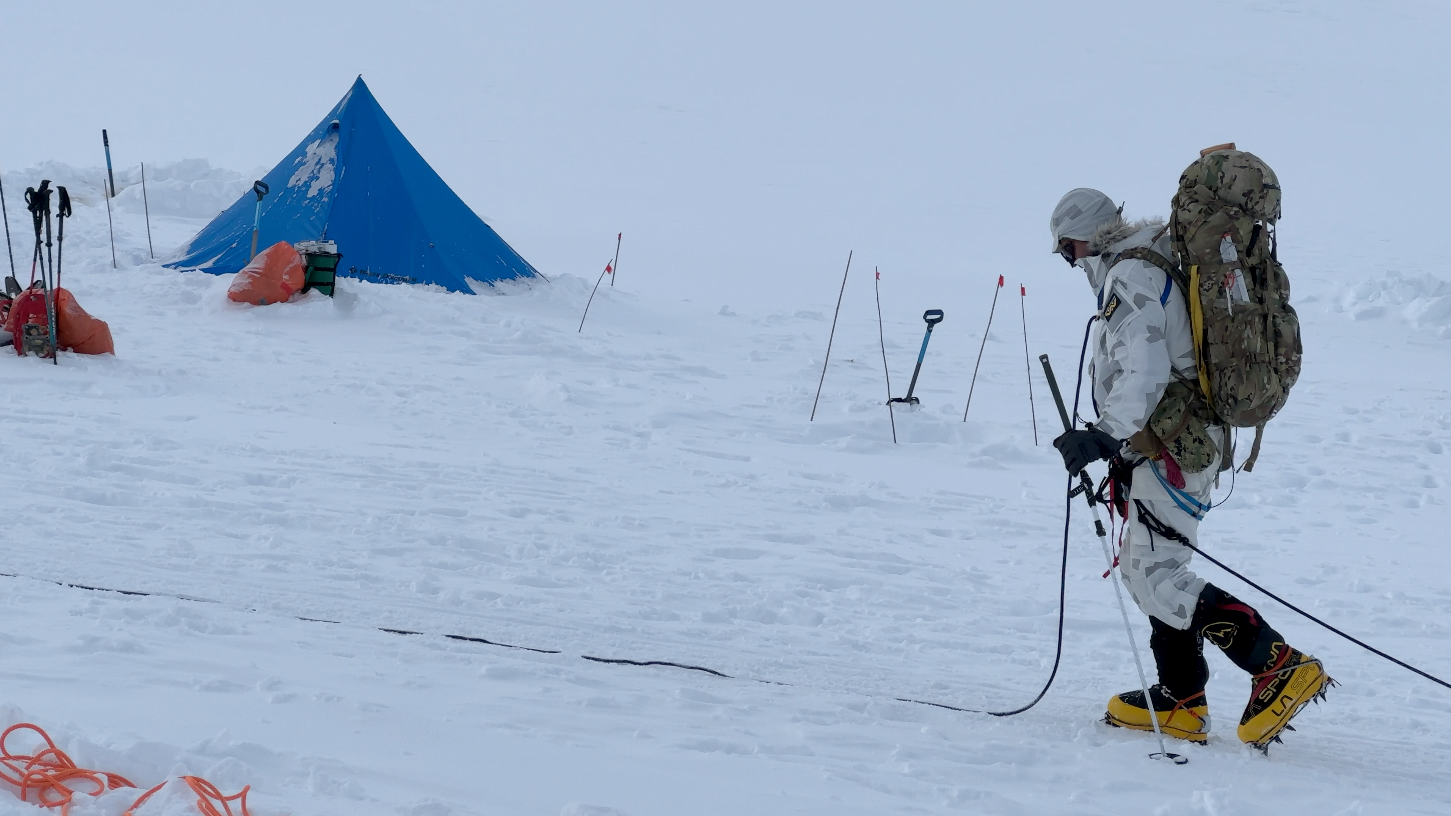
On May 17th, I knew something good was happening when we saw the long train of Navy Seals pulling out of camp in their matching winter combat uniforms. The forecast for today was originally dismal. More of the same. And I was falling into a depressive, fretful state. With each day that passed, we ate more of our supplies and I kept thinking about our summit chances. We’d spent six nights at 11,000ft, which may still be in the realm of normal, but it felt long. 14 camp is the main staging ground where you wait for your summit window. And I knew we still had a mandatory four to five days up there to acclimate and kill time, so I started getting nervous.
But the wind had died. We got the signal from Mike that today was going to be a move day. My morale spiked immediately, and I played music out loud on my phone as we packed up our camp.
But my pack was heavy, likely in the 80+ pound range. I started to realize at this point how inefficiently I had packed. Mostly with food and layers I just didn’t need.
We climbed back up to the Polo Field and while we were breaking there, my overloaded bag tumped over and an entire group meal got loose from the top opening. Before I could react, it gained speed and skittered out of my reach and down the hill. The meal came to rest in the middle of a crevasse field far below us. It wasn't recoverable. I felt deeply ashamed. I was leaving stuff on the mountain. In addition, group meal food is precious. The guides told me to shake it off, but it shattered my good mood.
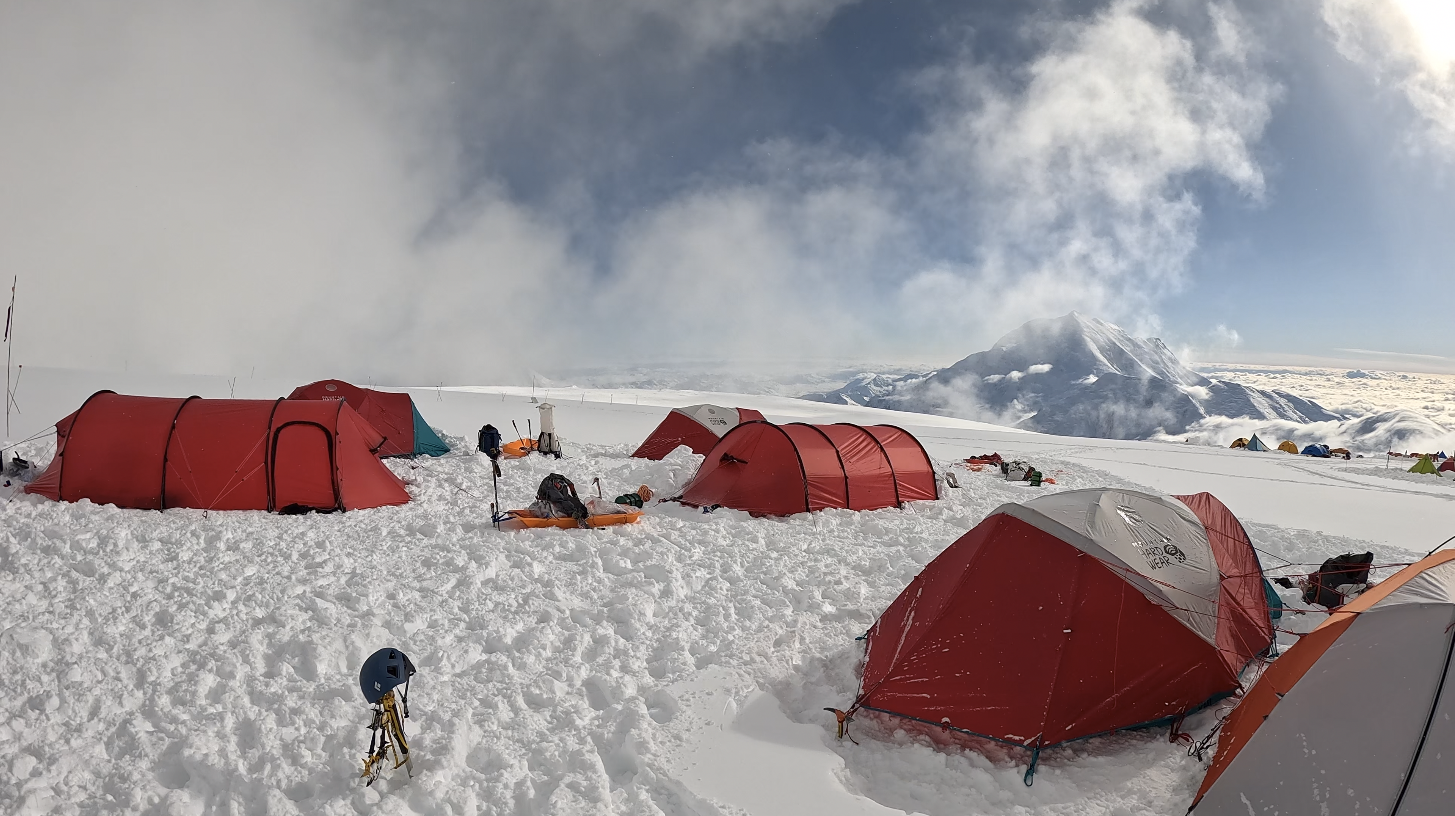
We built camp at 14 and settled in. Over the next three days, we retrieved our cache from 13,500ft, and we rested, restlessly. We lived vicariously through the park service as they snagged more beautiful lines above 14 camp, and took in the evening views of the Range. We kept receiving reports of massive winds up high and sometimes I could hear it roaring off the buttress like a freight train. We heard from the rangers that a couple of climbers at 17,000ft, the high camp, were in their tent when it disintegrated around them. They had to wrap themselves in the remaining nylon to stay alive.
On May 20th, we got our opening with the weather and packed up supplies to go cache at 17,000ft. To do this, you head up the incline behind 14 camp and up about 800 feet of fixed lines to the top of the West Buttress. At the foot of the fixed lines, it’s pretty common for teams to bottleneck as they attach themselves to the ropes and move over the bergschrund. The Navy Seals became our ever-present companions.
Moving up the fixed lines is tedious and slow with a crowd, but the top reveals one of the most stunning views of the trip. You can take in the Peters Glacier on one side, the Kahiltna on the other, and, on a good day, the other peaks in the Alaska Range spreading far into the distance.
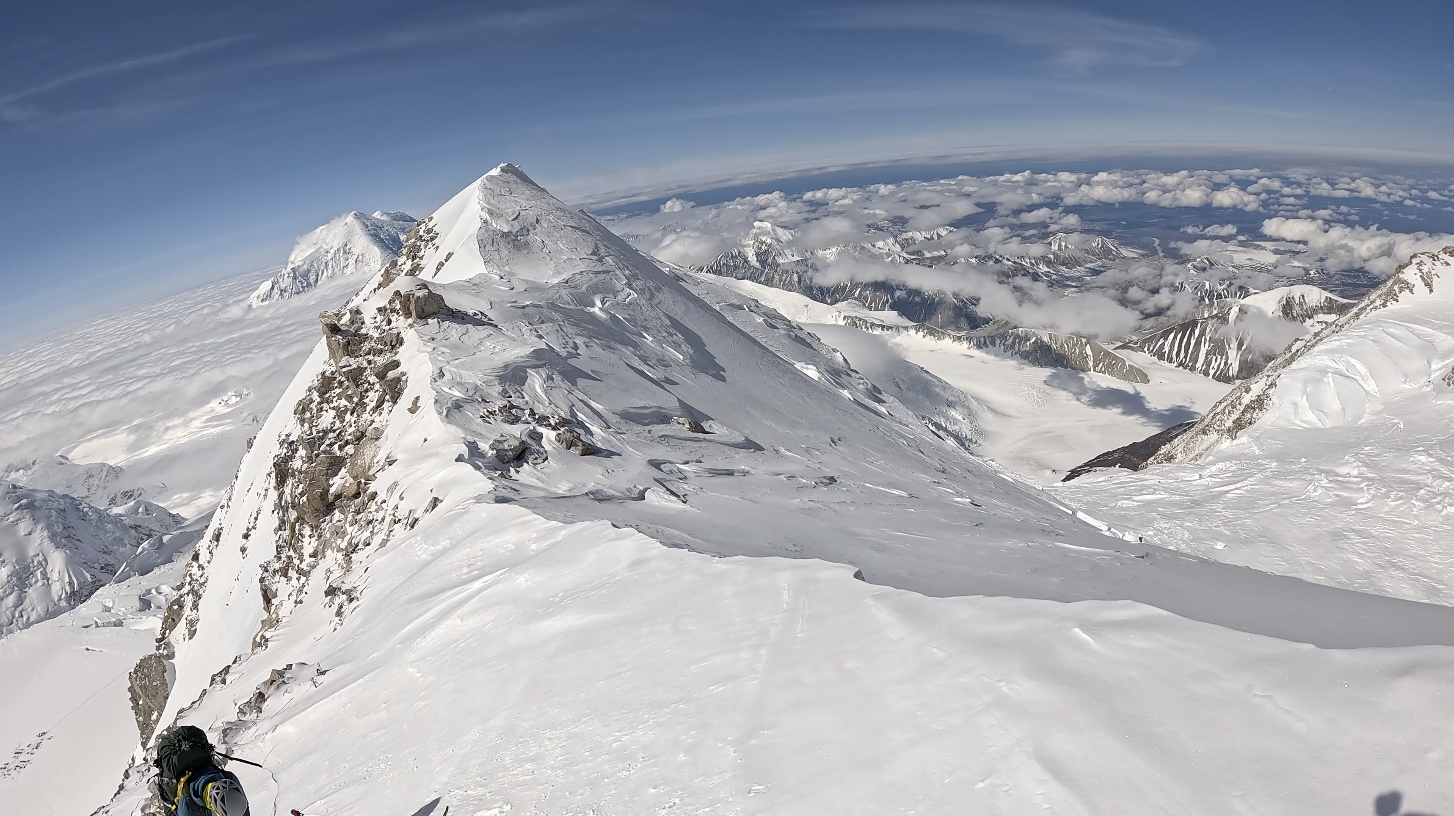
From here, you progress up the sharp ridge using a running belay system, since there’s lots of exposure on both sides. You climb around Washburn’s Thumb, a large granite formation, and continue up and around a few hills to get to 17 Camp.
It was only when I stopped moving that I could tell the air was noticeably thinner. And I also understood why we waited for the right moment to come here. The plateau at 17 Camp is a wind-scoured, inhospitable place. The snow is so compacted that most climbers don’t bother to attempt snow walls to protect their tents, and instead choose a time when the weather chills out.
It was at this time we learned that someone had died on the route. We saw the search and rescue rangers descending to the base of the “Autobahn,” which is the infamous section that runs between 17 Camp and Denali Pass. It’s a steep slope, where, if you lose your footing and can’t arrest immediately, your chances of survival are very low. The face runs for almost two thousand feet and any fall would take you through a morass of seracs and crevasses. Apparently, this was the fate of a Japanese solo climber. A helicopter arrived and carried the body away while we watched.
We descended back to 14 the way we came.
It was back to waiting again. Three days passed. Too much wind, bad weather, and more foul reports from up high on the radio. We could all feel the tension. Could we go back up there? I’d left fresh socks in the cache at 17 Camp that I wondered if I’d see again. We continued to eat through our supplies, now lessened by my earlier mistake where I’d fed a group meal to the glacier. To pass the time, we built snow walls around the camp. Though 14 Camp gets windy sometimes, we didn’t genuinely need them. But it was nice to sink into the rhythms of cutting and hauling snowblocks. It was something to occupy our thoughts.
The morning of May 24th, the wind finally calmed. As soon as I heard the stoves fire up sometime around 7:00am, I knew we were going up. I’d begun an unhealthy pattern where I’d feel extremely energized when we’d move and then sink into a kind of despair when we’d stop for any length of time. That familiar crunch of the snow as we moved out of camp lifted my spirits.
We retraced our steps from the caching run, up the fixed lines, across the ridge, and into 17 Camp. The route was pretty crowded with all of the different teams tracking the same weather window.
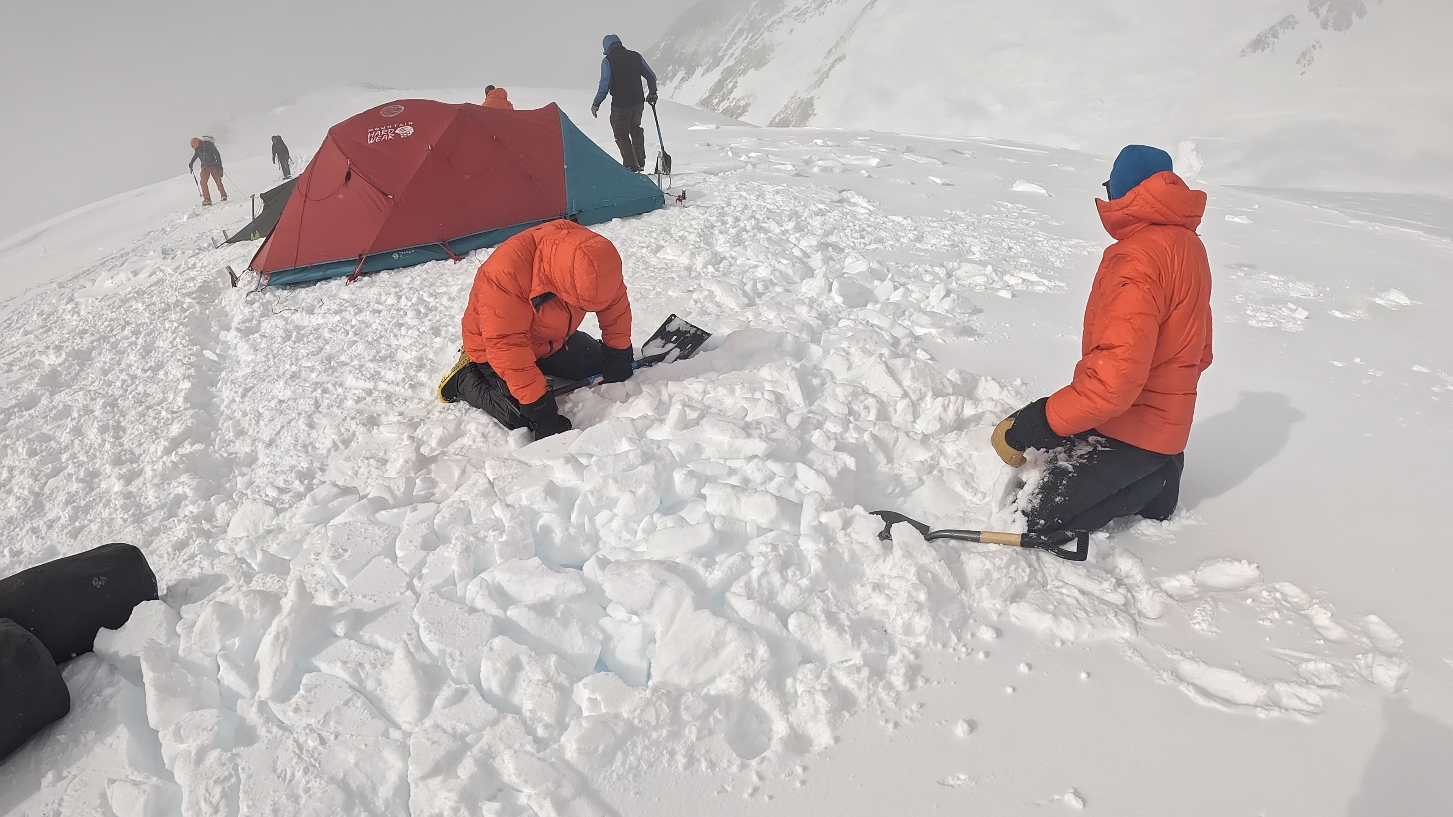
This time we had to chop out platforms and set up the tents. RMI keeps a cache up there with spades which made breaking up the wind-hardened snow a lot easier, but doing any kind of labor at this elevation saps your energy very quickly. We each had to take frequent breaks.
When we got camp set up, we briefly took in the scenery and then hopped into the tent to escape the dropping temps.
We were prepared to make our summit bid the next day, but the winds picked up. On May 25th, we just kicked around camp again. I was beside myself in anticipation and fear that the conditions wouldn’t give us our chance. We’d come so far.
Mike briefed us before we went to bed to be ready to go early the next day, the latest forecast looked good. But the winds really went crazy that night, whipping the tent with powerful gusts until 1am or so. I barely slept. But somewhere in the wee hours of the morning, the air deadened and it was silent.
Mike gave us the signal to start readying around 6am. I’d slept for a total of two or three hours but I didn’t care at all. I just wanted to get this thing done. We hurried through breakfast, fixed ourselves to our ropes, and headed toward the Autobahn.
It doesn’t seem all that bad when you’re on it. Just a traverse up a high-angle slope. But it’s unforgiving. It’s easy to see how people underestimate this section, make a mistake, and meet their ends down in the thicket of broken ice below.
We crossed Denali Pass, hung a right, and climbed past Zebra Rocks. One member of our party was forced to turn back around 19,000ft due to altitude sickness and hypothermia.
We continued past Archdeacons Tower to the Football Field, at 19,600ft. We could see huge clouds of spindrift rocketing off of the summit ridge above. On a break, our guide, Jess, stressed to us that there was no guarantee we’d be crossing the ridge to the summit. But since we were protected from the prevailing wind by the ridge itself, we were going to climb Pig Hill, the last rise, and see how conditions looked at that point. At this altitude, I took two huge breaths for every step.
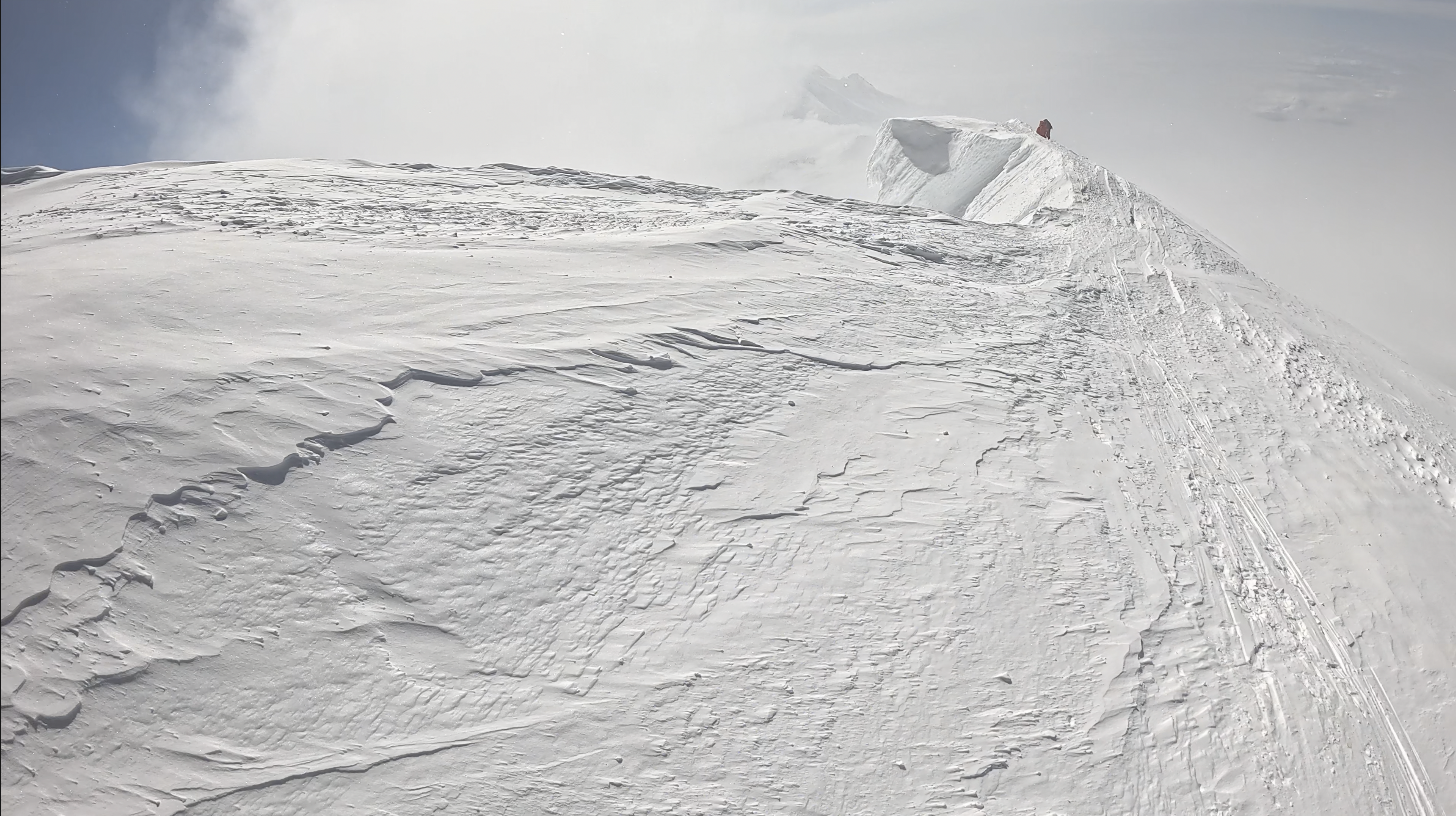
We gained the summit ridge. As if by magic, the wind ceased. We decided to continue across the last segment of the route to the summit.


I didn’t really feel the significance of the moment on the tallest point on the mountain, which is also the tallest point in North America. I was more focused on the altitude, the cold, and my own exhaustion. But I burst into tears when we got back down to the Football Field and it all hit me. Not only was that success the culmination of 20 days on the mountain and a lot of suffering to that point, it fulfilled an ambition I’d set out two years earlier. Ever since that pivotal experience I’d had on the Grand Teton, Denali was almost constantly on my mind. I felt immense gratitude toward everyone who’d helped me get to that point: The guides, my family, and friends. It's still unreal to me that it's done.
After 20 days to get to the summit, it took us two days to get back down to basecamp from 17,000ft. They were some of the most harrowing of the trip. Hauling my gear from 14,000ft to 11,000ft was incredibly taxing. My pack was so hideously overloaded. Then, from 11,000ft we hauled sleds downhill through the middle of the night across the Kahiltna to cross the snow bridges while they were frozen and strong. We were hoping for the beautiful alpenglow, but we were mostly socked in by low-hanging clouds. I can only describe this part of the climb as “mirthless toil.”
When we arrived at Heartbreak Hill, named so for being the final uphill segment of the climb before the airstrip, I felt nothing but excitement for my cache of whiskey at the top. It’s rare to find something as acutely aggravating as managing a loaded sled on the downhill. The PVC pipe rig I used to keep it behind me kept breaking and malfunctioning so that the whole apparatus would swing out in front and cut across my path. I was at the end of my tether and just left it in its mangled state for the last two hours of our return.
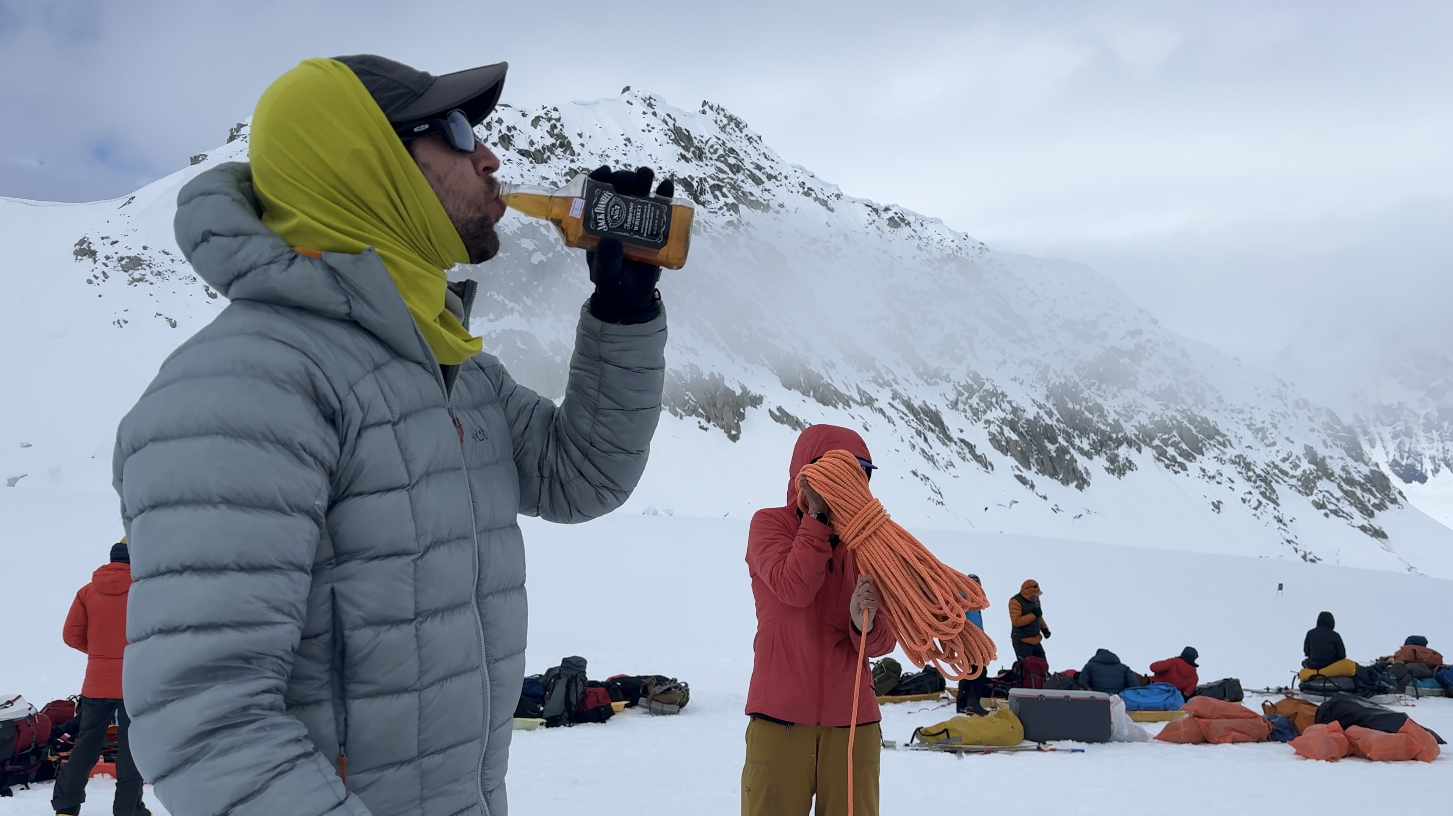
Back at Basecamp, we finally relaxed and the exhaustion of the past week settled over me. It was 9:00am, but we all took pulls from the booze we brought and waited for our planes. Fortunately, the weather cleared fast and the familiar red Otters of K2 Aviation swept us back to Talkeetna. I kept nodding off in my seat.
When we landed, we all took our shoes off to walk in the grass. I marveled at the trees, the sounds of birds, and the warmth of the air.
After a long shower, I closed out my time in Talkeetna with a final night out on the town. I ate two dinners, one at the Burger Barn and the other at Denali Brewing. Food is really nice when it hasn’t been freeze-dried. We also stopped in for an obligatory drink (or five) at the Fairview Inn, which is the traditional town watering hole for climbers and aviators.
I’ve been planning for and thinking about Denali for so long. I’m grateful to have spent so much time with the mountain, to have been there with a good crew, and to have reached the top safely. Only days after we flew off the glacier, members of a Malaysian team were stranded below the summit for four days. One of them died while awaiting rescue, the other two were subjected to severe frostbite.

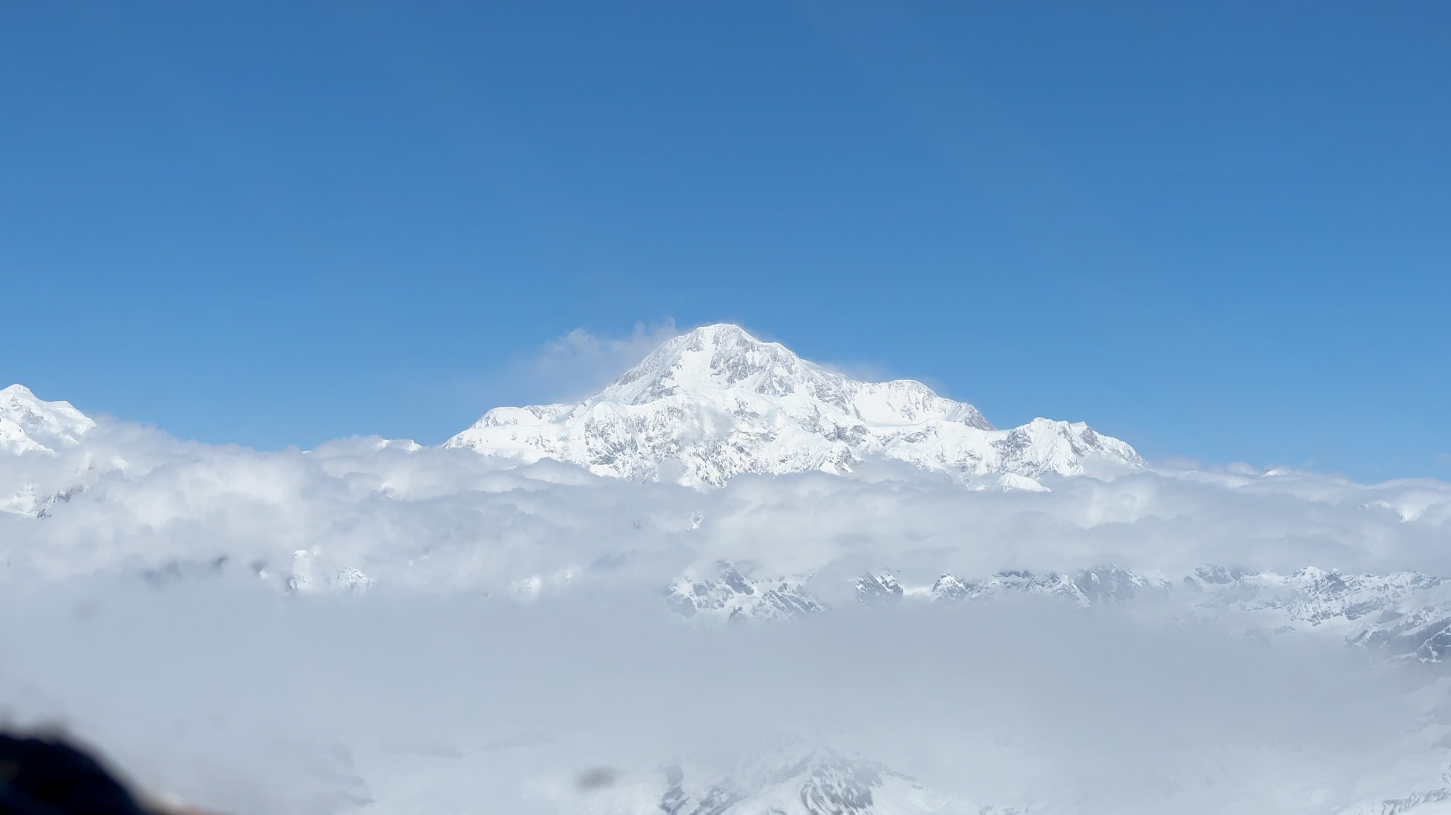
It’s a strange feeling to have the climb in the rearview mirror. There’s a kind of fallout in your life after a big experience like this and I think it’s going to take a while to just settle back into normal routines, and to figure out what’s next. Until then, I’m going to enjoy time with my family, and on-demand hot water.
Gear and recommendations
Note: I was on a guided team, so the cooking gear and tents weren't up to me. I would check out this piece from Brian Goes on Adventures for his views on cookware, tents, etc. That said, I really loved our Mountain Hardware Trango 3P.
My gear/layers load-out
- Backpack: Mountain Hardwear AMG 105. I wouldn't go less than 100 liters unless you really know what you're doing.
- Sleeping bag: Mountain Hardwear Phantom -40F. I felt like a -40F sleeping bag was essential. You could go lighter, but I had no regrets about the extra bulk. The temperature rating is supposed to be to what degree the average sleeper will keep warm. But this is in ideal conditions where the bag is perfectly lofted and whatnot. I felt barely warm when it was -25F at 14 camp.
- Parka: Mountain Hardwear Absolute Zero parka. Since it's built for the likes of Everest, many people think this is overkill for Denali. It definitely kept me warm though. Consider something like this if you run cold. I would go with a dedicated 6000m parka next time that compacts better.
- Boots: La Sportiva G2 Evo. No issues, personally. I have long, narrow feet though. Many others on my team opted for Scarpas and detested the La Sportiva fit.
- Overboots: Forty Below. I never used these except for around camp over my camp booties. Would absolutely recommend going with an 8000m boot instead of doubles + overboot though.
- Gloves:
- Arcteryx Venta touring gloves - I wore these on all of the warmer days, like on the lower Kahiltna, for sun protection
- Mountain Hardwear Exposure 2 Gore-Tex gloves - I wore these on all of our moving days (even summit day with hand warmers)
- Insulated Japanese fishing gloves – such a good camp gloves. I have this pair.
- Marmot 8000m Mitts – Didn't wear, but there for emergencies. I wouldn't go without them
- Glacier glasses: Smith Embark (x2). One for backup. These were terrific. The Julbos don't fit my face for some reason.
- Hat: A standard 5-panel cap. Bring a hat!
- Goggle: Smith 4D Mag. I wore only on summit day. I only brought the low-light lens. You're going to be in your glacier glasses for the high-light days anyhow.
- Helmet: Petzl Meteor. No complaints.
- Trekking pole: Black Diamond Expedition 3. Just a solid, collapsible pole. I use it for touring back home too.
- Axe: Petzl Summit Evo. No complaints. Love this thing.
- Harness: Petzl Tour. Solid.
- Carabiners: Petzl Triact + 5 Black Diamond non-lockers + 2 Black Diamond screwgates
- Straps for sled: I brought 4 bungees and only really needed 3
- Crampons: Black Diamond Sabretooth 12-point, steel, semi-automatic. I had trouble with these popping off on occasion. Fortunately, nowhere that mattered. But I would spend more time fitting or trying different ones that tighten down rock solid. Don't bring aluminum.
- Duffles: Mountain Hardwear Camp 4 135L (used on the sled) and Mountain Hardwear Expedition 100L (used to transport gear to Talkeetna; left in the hangar). These were great. The waterproofing on the Camp 4 was nice on the snowier days.
- Other layers
- Black Diamond sunshirt (x2) – Base layer. I would only bring one next time
- Smartwool ski socks (x5) – I would only bring three pairs next time
- Smartwool Mountaineering Extra Heavy Crew Sock (x2) – I would only bring one pair next time. Used for my camp sock
- Arcteryx Motus boxer (x3) – Two or three is about right
- Patagonia Better Sweater – Didn't need
- Smartwool Smartloft jacket – Mid-layer. Almost never took this off. Wore over my base layer
- Outdoor Research Helium down jacket (no hood) - Mid-layer. Almost never took off. Wore over the Smartloft jacket. Wish I had a hood on this one
- Black Diamond Stormline rain shell – Didn't really use this, but I'd want to have it if I went back
- Black Diamond Vision parka – Heavy mid-layer/outerlayer. This was a workhorse for me. Most days this would be my outermost layer
- Black Diamond Dawn Patrol touring pants – I never took these off
- Rab Photon insulated pant – you want insulated pants that have a full side zip like this
- Camera gear:
- GoPro Hero 12 (my workhorse)
- GoPro Max 360 cam (for atmospheric shots around camp. Wish I used it more)
- iPhone 15 Pro (used this all the time. Gives an almost-SLR-looking quality on 4K 30)
- GoPro pole mount (incredibly useful)
- GoPro helmet strap mount (essential for situations where the hands were occupied)
Non-gear or clothing recommendations
- Crazy Creek camp chair is solid gold and worth every ounce of weight. I brought the Hex 2.0 backpacking version, which is what I'd recommend. Lightweight and small form factor.
- Sleep mask. Very nice because it doesn't really get dark in May or June.
- Gummy ear plugs. I found these to be very comfortable and very good at blotting out noise.
- Hand warmers. Four packs of two would be just fine. I only wore warmers on summit day.
- Warm camp booties. I brought the 40 Below ones (everyone has 'em). But they didn't fit in my boot shells, which I wanted for traction on occasion. I wore the 40 Belows around camp without much issue with no additional shell over them. Doing it again, I'd go for down booties with a waterproof layer.
- Pee bottle. I have the 48oz Nalgene Cantene. Highly recommend. Teammates with smaller pee bottles consistently reported wanting more space or being terrified of overflow in the sleeping bag. Don't tempt fate.
- Bowl with a lid. The lid is nice for retaining heat or turning the bowl into a sipping vessel.
- 32oz Nalgene wide-mouth bottles (x2). Two is totally sufficient. Do not opt for the narrow-mouth bottle. It will freeze solid and you'll be sad.
- 16oz Nalgene bottle. Use this as your thermos and extra water bottle.
- 40 Below Bottle Boots. There's a reason why everyone on the mountain has these. They are the way to go. Do not settle for less than 100% thermal coverage on your water bottle.
- Roll of toilet paper (x1). I thought I'd need so much more than I did. One would totally suffice next time. I brought 3 (!). My thinking was that I could use one as currency for stuff at 14 Camp if I needed anything, but it just ended up being extra weight and bulk.
- Sturdy plastic Spoon. Just bring one general purpose utensil. No need for more.
- Supplements:
- Creatine gummies. I bought these ones. I wouldn't bring the whole bag next time, just 40 (plan 2 per day). I do think they help with recovery and retaining muscle.
- AG1/protein powder mix. AG1 is good because you're not getting any fresh veggies or fruits, but make sure that you have a good way of sealing it. Something sturdy. My Ziploc kept failing and the stuff gets everywhere.
- Metamucil capsules for fiber and keeping things moving. I'd bring like 60 and take 3 per day for 20 days. Can't recommend enough! You're eating heavy food and not a lot of fiber.
- Probiotics. I took these with the Metamucil and Creatine.
- 4x tubes of Nuun electrolytes. Very nice to flavor water from a pot that tastes a little like ramen.
- Fingernail clippers
- Small hand sanitizer bottles (x2)
- Solar panel (Goal Zero). I brought the Nomad 10-watt and it's all you need.
- Limit 1 or 2 batteries for the Goal Zero. Maybe one Flip 36 that you charge frequently. I brought way too many because I thought I'd need them all with my phone, camera gear, Kindle, and Airpods. But I didn't.
- Be very careful about misplacing the numerous things you’re carrying. Have strategies for organizing and keeping things together. Stuff sacks are your friend. Anticipate that it will snow a foot or more each night and bury items left outside
- Tea tree oil in small dabs works well to clean the feet and also make everything smell nice. Go with a small glass bottle that seals well.
- Wet wipes for approximating a shower. I brought 4 packs of the 24 counts. Too much, again. I'd stick with 2 packs next time.
- Baby powder for keeping feet dry in boots.
- Whiskey and pack of cigarettes for camp celebrations on the descent (I brought cigarettes on the climb and cached bourbon at basecamp).
- Diverse mountain lunch stuff. Some things I'd really recommend:
- Lots of different Haribo-style gummy candies
- Pringles (x3 cans) – Also make for great trash cans
- Kendal mint cakes (x5 or more) – I brought this kind. They're super high in glucose but really nice on those high-altitude days where nothing else sounds good and you know you need calories. They're a British mountaineering tradition and went up with the first successful Everest expedition.
Things I wish I had
- A better mid-layering system. More things with tight-fitting hoods. Look at bringing the following:
- Arcteryx Atom hoody mid layer
- Patagonia Nano Air
- Black Diamond Alpine Start wind layer. The guides lived in these and wore them over their sunshirts. Good for those days when it's warm but there's a breeze in the air.
- Mountain Hardwear Compressor jacket
- 8000-meter boots: Lots of people had the Scarpa Phantom 8000s or the La Sportiva Olympus Mons. These will save you so much heartache with fitting crampons to your doubles and overboots. Plus the high gaiter looked very nice.
- Backpacking pillowcase (thermarest): My tentmate had a big pillowcase that he could stuff with a puffy and I was extremely envious. I went without a pillow and just slept on my expedition parka the whole time which wasn't ideal.
- A 6000-meter parka (vs. an 8000-m parka). Something like the Feathered Friends Khumbu. I only used my big parka a few times and the Absolute Zero is a heavy, bulky piece of gear.
- A different backpack (probably). I didn't feel that the AMG 105 was all that comfortable around the waist. I had to crank down the hip straps as far as they'd go and often that wasn't enough to prevent the bag from slipping over my hip bones. Look at Hyperlite gear. Be sure you test a bag with a load of 70lbs or more on a hike for at least an hour to see how you like it.
- Better snacks. I went very heavy on technical nutrition (e.g. Shotblocks) and, for some reason, tuna fish. Variety is your friend. I'd bring lots of assorted gummy (Haribo) candies next time. More salami and cheese-type stuff (sliced very thin). Probably would skip the full jar of Nutella I brought. I would aim for 20-25 pounds of personal food next time, rather than 27.
- More movies. I burned through the three (that worked) in no time on our rest days. I brought the Lord of the Rings extended edition trilogy but downloaded them to the Google TV app (which I was horrified to discover wanted a network connection to let me watch downloaded content! Wtf!). Verify that all your stuff works offline.
- Less weight, overall. Some of the days we didn't have sleds were totally punishing and I felt every ounce of stuff I didn't need.

